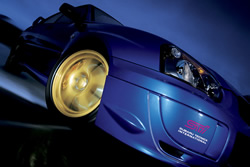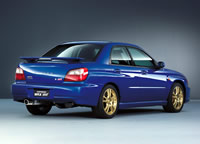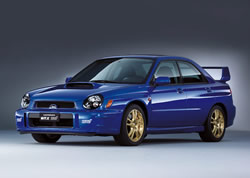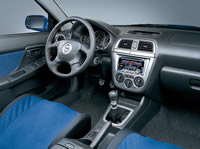 Zipping
through a narrow canyon course etched into walls of granite, a street-legal rally
car flows with the twisties on the Ortega Highway, California 74, which runs across
the Santa Ana Mountains from the Pacific Coast at San Juan Capistrano to Lake
Elsinore. Zipping
through a narrow canyon course etched into walls of granite, a street-legal rally
car flows with the twisties on the Ortega Highway, California 74, which runs across
the Santa Ana Mountains from the Pacific Coast at San Juan Capistrano to Lake
Elsinore.
Actually,
we're flying through this convoluted course, working the sporty Momo steering
wheel and plying a Prodrive six-speed gearbox with the turbo-charged and inter-cooled
engine whining and Potenza rubber wailing, all simply to see just what this thing
can do. And
it can do a lot. We're
talking pin-your-ears-to-the-seat accelerations and king-of-the-street speeds
in a relatively lightweight four-door package patterned after World Rally Championship
(WRC) race cars.  This
turbo-charged sports sedan from Japanese automaker Subaru is called the Impreza
WRX STi. This
turbo-charged sports sedan from Japanese automaker Subaru is called the Impreza
WRX STi.
It's
based on the subcompact Impreza platform and derived from Subaru's WRX performance
car but with more juice from a larger engine and more sporty paraphernalia to
cede no street race from "The Fast and the Furious" crowd. Those
STi initials on souped up WRX signify Subaru Technica International, the motorsports
division of Subaru and the force behind Subaru's trophy-collecting rally cars.
What's
a rally car?
It's
a race car usually of small scale with some stock equipment aboard but also a
high-output engine and modifications for added safety like a protective roll cage
and five-point racing harnesses for the two front seats. Rally
races pit a driver and co-pilot/navigator in a special race car against a stopwatch
and detailed route maps, with daredevil competitors tearing across treacherous
roads through cities and countryside, each vying to nail all checkpoints on time
and beat the clock across a finish line. Beyond
North America in countries around the world, automobile rally racing receives
the kind of sports attention that football fans in the United States reserve for
contests like the Super Bowl. And in the WRC Subaru has racked up multiple wins,
thanks to the wily nature of Subaru rally cars spinning off the Impreza platform. The
new 2004 WRX STi, also using the Impreza as its foundation, emulates those Subaru
rally cars, only without roll bars and five-point safety belts. In
fact, Subaru's current WRX rally race car is based on the production model WRX.
Differences
between street car and rally racer concern special modifications to the engine
plus the addition of heavy-duty and adjustable suspension components, special
seam welding of the structure to endure harsh punishment on a rally course, and
the rally roll cage.
The
STi edition varies from production model WRX in terms of powertrain and gearbox,
with special mechanical equipment added to enhance performance and handling.

Displacement
increases over the WRX plant, rising from 2.0 liters to 2.5 liters. That's the
largest displacement ever for a WRX STi model and it goes exclusively to the North
American market. It's
also the most powerful four-pack in America, thanks to a turbo-charger and inter-cooler
aboard to boost output and score some awesome muscle numbers.
It
makes an incredible 300 hp at 6000 rpm plus as much torque as 300 lb-ft at 4000
rpm. The boxer engine has a reinforced block with forged aluminum alloy pistons
and carbon steel connecting rods. Then Subaru adds the active valve control system
(AVCS) variable valve timing to optimize engine efficiency. STi's
turbo-charger comes directly from Subaru's WRC racers with the boost climbing
to 14.5 psi, while a big-capacity inter-cooler uses a manually-controlled water
spray for additional cooling.
All
of that power channels through a close ratio manual six-speed transmission developed
by Prodrive. The tight-shifting stick contains double-cone synchronizers for first,
third and reverse gears, plus a triple-cone on second and an internal oil pump
for heavy-duty workouts.
There's
no choice about the traction mechanism, however, as all of the vehicles that Subaru
ships to America arrive with an all-wheel-drive (AWD) system that's always engaged.
Torque muscle from the turbo-charged engine moves directly through an electronically-controlled
intelligent transfer case to whichever wheels can maintain a bite of traction,
with scant loss of energy in the process.
Subaru's
driver control center differential (DCCD) enables the STi driver to manually manage
torque directed to front and rear wheels for performance handling. Set the DCCD
in automatic mode, however, and it will distribute the torque in various ways
based on the driving conditions. Further,
the STi uses a limited-slip differential in front and back for additional tire
traction.
A super-stiff body structure from Subaru's ring-shaped reinforcement
frame contains a hydroformed front subframe with the four-wheel independent suspension
system derived from Subaru WRC competition cars but tweaked for tight cornering
control on paved roads.
It's
similar to the suspension on WRX, only dropped by almost half an inch to set up
a lower center of gravity. And
to rein all of those STi horses, there are serious brakes aboard with huge Brembo
discs visible between aluminum spokes of the 17-inch BBS wheels.
Treads
on the pavement consist of wily Bridgestone Potenza RE070 tires at 225/45ZR17.
Brakes link to electronic brake-force distribution (EBD) and a new anti-lock braking
system (ABS) capable of governing brake forces at each wheel individually.
Exterior
styling for the STi, inspired by Subaru WRC racers, capitalizes on a wide wheel
track with squarish blister fenders to bulge the front end plus a contoured aluminum
hood supporting the enlarged air scoop.
 A
functional cockpit design positions two bolstered buckets beside a central console
housing the shifter stick. Steering wheel is a three-spoke Momo in gray leather
with red stitching and it makes only three turns lock-to-lock. A
functional cockpit design positions two bolstered buckets beside a central console
housing the shifter stick. Steering wheel is a three-spoke Momo in gray leather
with red stitching and it makes only three turns lock-to-lock.
The
bottom line: MSRP for racy WRX STi is $30,995.
Click here for more information on the Subaru WRX STi.
For the Subaru 2004 Model Guide : Click
Here |